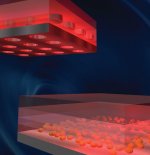Research published in the industry journal Advanced Materials shows organic single-junction solar cells have now reached efficiency levels of ten percent, putting them in direct competition with photovoltaic cells based on amorphous silicon.
A group of scientists from the University of Buffalo, building on recent breakthroughs in nanotechnology – which have dramatically enhanced the power conversion levels of organic solar cells – say their work could potentially lead to a new generation of photovoltaic materials that could outperform and cost less to produce than current solar panels.
The Advanced Materials paper, entitled “Plasmonic-Enhanced Organic Photovoltaics: Breaking the 10% Efficiency Barrier,” published May 7, details the work of Qiaoqiang Gan, UB assistant professor of electrical engineering.
Gan’s research focuses on the production of thin-film organic polymers, which can be manufactured in liquid form, like paint, thus allowing the material to be applied to a wide variety of surfaces over a larger area.
But unlike other thin-film solar cells that use toxic or expensive elements such as cadmium telluride to trap and convert sunlight, Gan and his team found that by incorporating carbon-based plasmonic nanostructures into their organic solar cells, they could boost efficiency levels to the10 percent capacity required to make the technology commercially viable.
A plasmon in this application refers to the enhanced light-absorbing characteristics of a nanostructure on the surface of a solar cell that occurs when electrons oscillate rapidly. Due to recent breakthroughs in the field of nanotechnology, Gan and the paper’s co-authors say it is time for serious consideration into how nanomaterials and plasmonic strategies can create more efficient and affordable thin-film organic solar cells.
“Compared with their inorganic counterparts, organic photovoltaics can be fabricated over large areas on rigid or flexible substrates potentially becoming as inexpensive as paint,” Gan said.
Gan co-authored his paper with Filbert J. Bartoli, professor of electrical and computer engineering at Lehigh University, and Zakya Kafafi of the National Science Foundation.
Source/image source









































